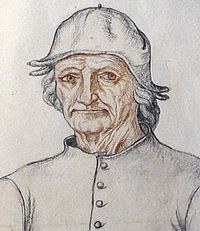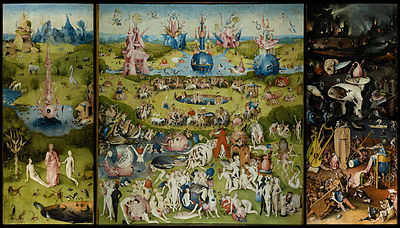- Hieronymus Bosch
-
Hieronymus Bosch 
Attributed to Jacques Le Boucq, Portrait of Hieronymus Bosch. c. 1550Birth name Jeroen Anthoniszoon van Aken Born 1450
's-Hertogenbosch, Duchy of Brabant (Netherlands)Died Buried on 9 August 1516 Nationality Netherlandish Field Painting Movement Early Netherlandish Renaissance Works The Garden of Earthly Delights
The Temptation of St. AnthonyHieronymus Bosch (English pronunciation: /ˌhaɪ.əˈrɒnɨməs ˈbɒʃ/, Dutch: [ɦijeːˈɾoːnimʏs ˈbɔs]; born Jeroen Anthoniszoon van Aken Dutch pronunciation: [jəˈrun ɑnˈtoːnɪsoːn vɑn ˈaːkə(n)]; c. 1450 – 9 August 1516), was a Dutch painter. His work is known for its use of fantastic imagery to illustrate moral and religious concepts and narratives.[1]
Contents
Life
Hieronymus Bosch was born Hieronymus (or Jeroen, respectively the Latin and Middle Dutch form of the name "Jerome") van Aken (meaning "from Aachen"). He signed a number of his paintings as Bosch (pronounced Boss in Middle Dutch). The name derives from his birthplace, 's-Hertogenbosch, which is commonly called "Den Bosch".
Little is known of Bosch’s life or training. He left behind no letters or diaries, and what has been identified has been taken from brief references to him in the municipal records of 's-Hertogenbosch, and in the account books of the local order of the Brotherhood of Our Lady. Nothing is known of his personality or his thoughts on the meaning of his art. Bosch’s date of birth has not been determined with certainty. It is estimated at c. 1450 on the basis of a hand drawn portrait (which may be a self-portrait) made shortly before his death in 1516. The drawing shows the artist at an advanced age, probably in his late sixties.[2]
Bosch was born and lived all his life in and near ‘s-Hertogenbosch, a city in the Duchy of Brabant. His grandfather, Jan van Aken (died 1454), was a painter and is first mentioned in the records in 1430. It is known that Jan had five sons, four of whom were also painters. Bosch’s father, Anthonius van Aken (died c. 1478) acted as artistic adviser to the Brotherhood of Our Lady.[3] It is generally assumed that either Bosch’s father or one of his uncles taught the artist to paint, but none of their works survive.[4] Bosch first appears in the municipal record in 1474, when he is named along with two brothers and a sister.
's-Hertogenbosch was a flourishing city in fifteenth century Brabant, in the south of the present-day Netherlands, at the time part of the Burgundian Netherlands, and during his lifetime passing through marriage to the Habsburgs. In 1463, 4,000 houses in the town were destroyed by a catastrophic fire, which the then (approximately) 13-year-old Bosch presumably witnessed. He became a popular painter in his lifetime and often received commissions from abroad. In 1488 he joined the highly respected Brotherhood of Our Lady, an arch-conservative religious group of some 40 influential citizens of 's-Hertogenbosch, and 7,000 'outer-members' from around Europe.
Sometime between 1479 and 1481, Bosch married Aleyt Goyaerts van den Meerveen, who was a few years older than the artist. The couple moved to the nearby town of Oirschot, where his wife had inherited a house and land from her wealthy family.[5]
An entry in the accounts of the Brotherhood of Our Lady records Bosch’s death in 1516. A funeral mass served in his memory was held in the church of Saint John on 9 August of that year.[6]
Art
Bosch produced several triptychs. Among his most famous is The Garden of Earthly Delights. This painting, for which the original title has not survived, depicts paradise with Adam and Eve and many wondrous animals on the left panel, the earthly delights with numerous nude figures and tremendous fruit and birds on the middle panel, and hell with depictions of fantastic punishments of the various types of sinners on the right panel. When the exterior panels are closed the viewer can see, painted in grisaille, God creating the Earth. These paintings—especially the Hell panel—are painted in a comparatively sketchy manner which contrasts with the traditional Flemish style of paintings, where the smooth surface—achieved by the application of multiple transparent glazes—conceals the brushwork. In this painting, and more powerfully in works such as his Temptation of St. Anthony (Museu Nacional de Arte Antiga, Lisbon), Bosch draws with his brush. Not surprisingly, Bosch is also one of the most revolutionary draftsmen in the history of art, producing some of the first autonomous sketches in Northern Europe.
Bosch never dated his paintings. But—unusual for the time—he seems to have signed several of them, although other signatures purporting to be his are certainly not. Fewer than 25 paintings remain today that can be attributed to him. In the late sixteenth-century, Philip II of Spain acquired many of Bosch's paintings, including some probably commissioned and collected by Spaniards active in Bosch's hometown; as a result, the Prado Museum in Madrid now owns The Garden of Earthly Delights, the circular tabletop of The Seven Deadly Sins and the Four Last Things, the The Haywain Triptych and The Stone Operation.
Interpretations
In the twentieth century, when changing artistic tastes made artists like Bosch more palatable to the European imagination, it was sometimes argued that Bosch’s art was inspired by heretical points of view (e.g., the ideas of the Cathars and putative Adamites) as well as of obscure hermetic practices. Again, since Erasmus had been educated at one of the houses of the Brethren of the Common Life in 's-Hertogenbosch, and the town was religiously progressive, some writers have found it unsurprising that strong parallels exist between the caustic writing of Erasmus and the often savage painting of Bosch. "Although the Brethren remained loyal to the Pope, they still saw it as their duty to denounce the abuses and scandalous behaviour of many priests: the corruption which both Erasmus and Bosch satirised in their work".[7]
Others, following a strain of Bosch-interpretation datable already to the sixteenth-century, continued to think his work was created merely to titillate and amuse, much like the "grotteschi" of the Italian Renaissance. While the art of the older masters was based in the physical world of everyday experience, Bosch confronts his viewer with, in the words of the art historian Walter Gibson, "a world of dreams [and] nightmares in which forms seem to flicker and change before our eyes." In one of the first known accounts of Bosch’s paintings, in 1560 the Spaniard Felipe de Guevara wrote that Bosch was regarded merely as "the inventor of monsters and chimeras". In the early seventeenth century, the Dutch art historian Karel van Mander described Bosch’s work as comprising "wondrous and strange fantasies"; however, he concluded that the paintings are "often less pleasant than gruesome to look at."[8]
In recent decades, scholars have come to view Bosch's vision as less fantastic, and accepted that his art reflects the orthodox religious belief systems of his age.[citation needed] His depictions of sinful humanity, his conceptions of Heaven and Hell are now seen as consistent with those of late medieval didactic literature and sermons. Most writers attach a more profound significance to his paintings than had previously been supposed, and attempt to interpret it in terms of a late medieval morality. It is generally accepted that Bosch’s art was created to teach specific moral and spiritual truths in the manner of other Northern Renaissance figures, such as the poet Robert Henryson, and that the images rendered have precise and premeditated significance. According to Dirk Bax, Bosch's paintings often represent visual translations of verbal metaphors and puns drawn from both biblical and folkloric sources.[9] However, the conflict of interpretations that his works still elicit raise profound questions about the nature of "ambiguity" art of his period.
Some writers attempt to interpret his imagery using the language of Freudian psychology. However, such theses are commonly rejected; according to Gibson, "what we choose to call the libido was denounced by the medieval church as original sin; what we see as the expression of the subconscious mind was for the Middle Ages the promptings of God or the Devil."[10]
Debates on attribution
The exact number of Bosch's surviving works has been a subject of considerable debate. He signed only seven of his paintings, and there is uncertainty whether all the paintings once ascribed to him were actually from his hand. It is known that from the early sixteenth century onwards numerous copies and variations of his paintings began to circulate. In addition, his style was highly influential, and was widely imitated by his numerous followers.[11]
Over the years, scholars have attributed to him fewer and fewer of the works once thought to be his, and today only 25 are definitively attributed to him.
Works
Main article: List of paintings by Hieronymus BoschNotes
- ^ Catherine B. Scallen, The Art of the Northern Renaissance (Chantilly: The Teaching Company, 2007) Lecture 26
- ^ Gibson, 15-16
- ^ Gibson, 15, 17
- ^ Gibson, 19
- ^ Valery, Paul. "The Phase of Doubt, A Critical Reflection".
- ^ Gibson, 18
- ^ The Secret Life of Paintings Richard Foster & Pamela Tudor-Craig ISBN 0-85115-439-5
- ^ Gibson, 9
- ^ Bax, 1949.
- ^ Gibson, 12
- ^ Gibson, 163
References
- Bax, Dirk. (1949), “Ontcijfering van Jeroen Bosch”. Den Haag.
- Gibson, Walter S (1973). “Hieronymus Bosch”. New York: Thames and Hudson. ISBN 0-5002-O134-X
- Koldeweij, Jos & Bernard Vermet & Barbera van Kooij: Hieronymus Bosch. New Insights Into His Life and Work, NAi Publishers, Rotterdam 2001. ISBN 9-0566-2214-5
External links
- Jheronimus Bosch Art Center
- Bosch Bruegel Society
- Hieronymus Bosch "Between Heaven and Hell" in the "A World History of Art"
- Hieronymus Bosch Gallery at ibiblio
- Bosch Universe
- VA Tech English Dept. Project - Details Hieronymus Bosch paintings and allows for close examination
- Hieronymus Bosch at Panopticon Virtual Art Gallery
- At the Museo Nacional del Prado
- "Hieronymus Bosch, Tempter and Moralist" Analysis by Larry Silver.
- Hieronymus Bosch's Seven Deadly Sins table painting Analysis by Anja Zeidler.
- A Musical About Hieronymus Bosch
- www.Hieronymus-Bosch.org 188 works by Hieronymus Bosch
- Short animation film about The Garden of Earthly Delights
Categories:- 1450s births
- 1516 deaths
- Dutch painters
- Dutch Christians
- Christian artists
- Early Netherlandish painters
- People from 's-Hertogenbosch
- Renaissance painters
Wikimedia Foundation. 2010.




